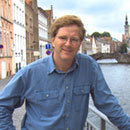Rick Steves’ Europe: Appreciating Italy's most underrated city, Milan
As we’ve had to postpone our travels because of the pandemic, I believe a weekly dose of travel dreaming can be good medicine. Here’s one of my favorite European memories from Milan — a reminder of the fun that awaits us at the other end of this crisis.
They say that for every church in Rome, there’s a bank in Milan. Indeed, the economic success of postwar Italy can be attributed, at least in part, to this second city of bankers, publicists, and pasta power-lunchers. While overshadowed by Venice, Florence, and Rome in the minds of travelers, Milan still has plenty to offer anyone who visits.
The importance of Milan is nothing new. Ancient Romans called this place Mediolanum, or “the central place.” By the fourth century AD, it was the capital of the western half of the Roman Empire. After struggling through the early Middle Ages, Milan rose to prominence under the powerful Visconti and Sforza families. By the time the Renaissance hit, Leonardo had moved here and the city was called “the New Athens.”
Milan’s cathedral, the city’s centerpiece, is the third largest church in Europe. It’s massive: 480 feet long and 280 feet wide, forested with 52 sequoia-sized pillars and populated by 2,000 statues. The place can seat 10,000 worshipers. Climbing the tight spiral stairs designed for the laborers who built the church, I emerge onto the rooftop in a forest of stony spires. Crowds pack the rooftop for great views of the city, the square, and, on clear days, the Italian Alps. But it’s the architectural details of the church that grab my attention. Marveling at countless ornaments carved more than five centuries ago in marble — each flower, each gargoyle, each saint’s face different — I realize the public was never intended to see this art. An expensive labor of love, it was meant for God’s eyes only.
The cathedral sits on Piazza del Duomo, Milan’s main square. It’s a classic European scene. Professionals scurry, fashionista kids loiter, and young thieves peruse.
The grand glass-domed arcade on the square marks the late19th-century mall, Galleria Vittorio Emanuele. Built around 1870, during the heady days of Italian unification, it was the first building in town with electric lighting. Its art is joyful propaganda, celebrating the establishment of Italy as an independent country. Its stylish boutiques, restaurants, and cafés reflect Milan’s status as Italy’s fashion capital.
I make the scene under those glassy domes, slowly sipping a glass of the traditional Italian liqueur, Campari, first served in the late 1800s at a bar in this very gallery. Some of Europe’s hottest peoplewatching turns my pricey drink into a good value. While enjoying the parade, I notice some fun-loving commotion around the bull in the floor’s zodiac mosaic. For good luck, locals step on the testicles of Taurus. Two girls tell me that it’s even better if you twirl.
It’s evening, and I see people in formal wear twirling on that poor bull. They’re on their way to what is quite possibly the world’s most prestigious opera house: La Scala. Like other great opera houses in Europe, La Scala makes sure that impoverished music lovers can get standing-room tickets or nosebleed seats that go on sale the day of the performance. And the La Scala Museum has an extensive collection of items that are practically objects of worship for opera devotees: original scores, busts, portraits, and death masks of great composers and musicians. Imagine: Verdi’s top hat, Rossini’s eyeglasses, Toscanini’s baton . . . even Fettucini’s pesto.
The next morning is the highlight of many Milan visits: Leonardo’s ill-fated The Last Supper, painted right onto the refectory wall of the Church of Santa Maria delle Grazie. Leonardo was hired to decorate the monks’ dining room, and this was an appropriate scene. Suffering from Leonardo’s experimental use of oil, the masterpiece began deteriorating within six years of its completion. The church was bombed in World War II, but — miraculously, it seems — the wall holding The Last Supper remained standing.
Today, to preserve it as much as possible, the humidity in the room is carefully regulated — only 30 people are allowed in every 15 minutes. When it's my turn to enter, I look right, and there it is. In the big, whitewashed room, the colors are faded, but the composition is dreamy. Leonardo captures the psychological drama as the Lord says, "One of you will betray me," and the apostles huddle in stressed-out groups of three, wondering, "Lord, is it I?"
When my 15 minutes of viewing are up, I emerge into the vibrant, modern city with renewed appreciation for Milan: Italy's most underrated city.
=========
(Rick Steves (www.ricksteves.com) writes European guidebooks, hosts travel shows on public TV and radio, and organizes European tours. This article was adapted from his new book, For the Love of Europe. You can email Rick at rick@ricksteves.com and follow his blog on Facebook.)
©2021 Rick Steves. Distributed by Tribune Content Agency, LLC.
(c)2021 RICK STEVES DISTRIBUTED BY TRIBUNE MEDIA SERVICES, INC.














Comments